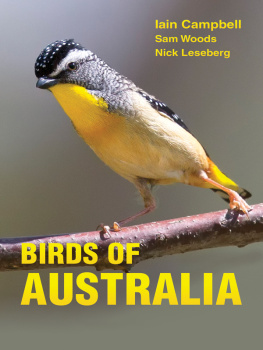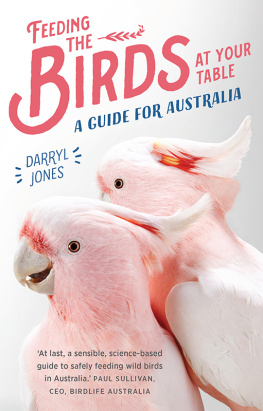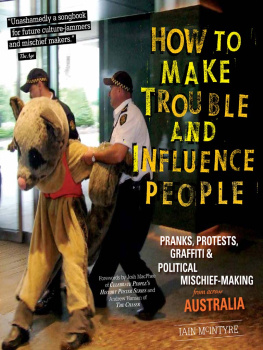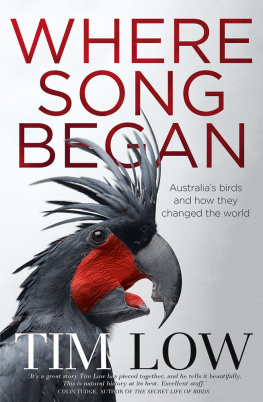Campbell Iain - Birds of Australia
Here you can read online Campbell Iain - Birds of Australia full text of the book (entire story) in english for free. Download pdf and epub, get meaning, cover and reviews about this ebook. year: 2014, publisher: Princeton University Press, genre: Children. Description of the work, (preface) as well as reviews are available. Best literature library LitArk.com created for fans of good reading and offers a wide selection of genres:
Romance novel
Science fiction
Adventure
Detective
Science
History
Home and family
Prose
Art
Politics
Computer
Non-fiction
Religion
Business
Children
Humor
Choose a favorite category and find really read worthwhile books. Enjoy immersion in the world of imagination, feel the emotions of the characters or learn something new for yourself, make an fascinating discovery.
- Book:Birds of Australia
- Author:
- Publisher:Princeton University Press
- Genre:
- Year:2014
- Rating:4 / 5
- Favourites:Add to favourites
- Your mark:
- 80
- 1
- 2
- 3
- 4
- 5
Birds of Australia: summary, description and annotation
We offer to read an annotation, description, summary or preface (depends on what the author of the book "Birds of Australia" wrote himself). If you haven't found the necessary information about the book — write in the comments, we will try to find it.
Birds of Australia — read online for free the complete book (whole text) full work
Below is the text of the book, divided by pages. System saving the place of the last page read, allows you to conveniently read the book "Birds of Australia" online for free, without having to search again every time where you left off. Put a bookmark, and you can go to the page where you finished reading at any time.
Font size:
Interval:
Bookmark:

BIRDS OF AUSTRALIA
BIRDS OF AUSTRALIA
A PHOTOGRAPHIC GUIDE

IAIN CAMPBELL
SAM WOODS AND NICK LESEBERG
PHOTOGRAPHY SUPPLIED BY GEOFF JONES
PRINCETON UNIVERSITY PRESS
PRINCETON AND OXFORD
Copyright 2015 by Princeton University Press
Published by Princeton University Press, 41 William Street,
Princeton, New Jersey 08540
In the United Kingdom: Princeton University Press, 6 Oxford
Street, Woodstock, Oxfordshire OX20 1TW
press.princeton.edu
Cover image: Spotted Pardalote (Pardalotus striatus). Photograph
copyright and courtesy of Iain Campbell.
All Rights Reserved
ISBN (pbk) 978-0-691-15727-6
Library of Congress Control Number: 2014933938
British Library Cataloguing-in-Publication Data is available
This book has been composed in Perpetua (main text) and Avenir
(headings and captions)
Printed on acid-free paper.
Images previous page: Rainbow Bee-eater (Merops ornatus),
top left; Squatter Pigeon (Geophaps scripta), top right;
Emu (Dromaius novaehollandiae), bottom left; New Holland
Honeyeater (Phylidonyris novaehollandiae), bottom right. All
photographs copyright and courtesy of Iain Campbell.
Designed by D & N Publishing, Baydon, Wiltshire, UK
Printed in China
10 9 8 7 6 5 4 3 2 1
CONTENTS
 ACKNOWLEDGMENTS
ACKNOWLEDGMENTS
Many people have contributed to this photographic guide, none more so than Geoff Jones, who made his complete collection of Australian bird photos available to the authors. For this we are very grateful. Descriptions of seabirds from Keith Barnes formed the base for that section of the book, which the authors freely admit is not their realm of expertise. Alan Davies helped with many of the shorebird descriptions. Rebecca Hinkle looked at the manuscript many times to help make it more accessible to non-Australian birders, for whom words like billabong and Outback are not second nature.
We would also like to thank Tropical Birding Tours for allowing us the time to get some of the required shots and to write this book. We give many thanks to editor Amy K. Hughes for turning our untidy submission into a proper manuscript, and to Robert Kirk and Ellen Foos at Princeton University Press, and to David and Namrita Price-Goodfellow and their design team at D & N Publishing. Finally, we want to thank our families for dealing with some late nights and temperamental moods when we were sorting through thousands of photos. We hope this book does everyone proud.
A Red-collared Lorikeet coming in to a dripping tap in the dry tropics

 INTRODUCTION
INTRODUCTION
Australia is a vast country with more than 700 regular bird species, most of which are found nowhere else. Cassowaries, chowchillas, sittellas, and other names are unfamiliar to many visitors from North America or Europe, and this can make bird identification seem daunting. This guide, with its easy-to-understand writing style, detailed photos, and clear distribution maps, is designed to help you identify the birds you seeand make your experience of the Australian bush much more fulfilling.
The goal of this book is to make birding and bird identification accessible to the vast majority of people, while still providing a resource to more experienced birders. To achieve this, the text is written in a casual style, in the way one birder would likely describe a bird to another birder; the most important feature first, be it the plumage, a restricted range, a habitat requirement, or a bizarre habit. Then a general description is given, along with the birds distribution, and how and where to find it. The key to birding in Australia is in understanding the habitats, so to really get the most out of this book, it is very important to read The Habitats of Australia section.
There are a few different checklists and taxonomic treatments of Australian birds. This guide almost always follows the International Ornithological Congress taxonomy (IOC World Bird List, version 3.3), as it is the most advanced in dealing with the Australian bird families. There are a few notable deviations from the IOC taxonomy, essentially predictive in nature, where it is expected that certain birds will be described as separate species in the near future. These extra splits include Naretha Parrot (from Bluebonnet), Golden-backed Honeyeater (from Black-chinned Honeyeater), Mallee Whipbird (from Western Whipbird), Western and Northern Shriketits (formerly lumped with Eastern Shriketit as Crested Shriketit), and Silver-backed Butcherbird (from Grey Butcherbird). The sequence is mostly taxonomic, but we made exceptions when putting similar-looking birds together (e.g., stork, pelican, and cranes on the same plate) makes for greater ease of identification.
Birds are rarely encountered at a standard distance or in perfect lighting, so although we are using photos for comparison of birds, the species do not appear in similar positions. The photos show the diagnostic features, but the birds are in a variety of positions, because you will be watching birds that are constantly moving. The presentation in most field guides looks very static, so we have put the chaos of nature into the book. The sizes of the images and the relative sizes of the birds within them have no relation and should not be used as an indication of species sizes. Photos that appear on left-hand pages are for artistic as much as identification purposes, and sometimes are used to show a bird in its habitat.
Bird calls and songs are very important for identification of a range of species and are well worth learning. We think that onomatopoeic descriptions do not do these vocalisations justice, and a birder is far better served learning the calls though recordings. We have elected not to devote much text to describing bird vocalisations, which do little to aid practical identification of the species.
The geographical range covered includes all of mainland Australia and Tasmania (TAS). The Cocos (Keeling) Islands, which are much closer to Java than to the Australian mainland; Lord Howe Island, 600km (375mi) east of the mainland; and Norfolk Island, which is closer to New Zealand than to Australia, are excluded, as they are very different from mainland Australia and better covered in individual volumes. The book deliberately excludes rare vagrants to the country; for the vast majority of users these would add confusion to the birding experience. The general rule is that unless recorded a few times a year, such a visitor is skipped. Most of these vagrants are hard to identify shorebirds or seabirds, and there are some very good resources for identifying them.

We generated the maps by using trip reports from birding tours, commercial private surveys, and records from The Atlas of Australian Birds from BirdLife Australia. Any survey or sighting is limited to accessible areas, which can be very erratic in remote regions. Large tracts of aboriginal, private, and government lands are off-limits to most people and have not been represented in any survey. There is also a very strong bias of records to more populated centres of the country and places that are birded frequently. We have tried to overcome this bias and lack of records from remote locations by extrapolating from known areas across the blank areas where the suitable habitat occurs. We use a mapping system in which the map does not show absolute population abundance of the bird, but rather shows relative abundance throughout its Australian range; faint shading shows where the bird is less common and darker shading shows where the bird is relatively more common. Some species, such as Australian Masked Owl, have such a sporadic distribution over a vast region that a standard type of map becomes almost useless, and distribution would be better represented by spots showing recent sightings. For a few species, such as the Australian Ringneck, we have mapped ranges of the individual subspecies. This is because the subspecies of this species look very different from one another, have overlapping ranges, and may be split out as separate species in the future.
Next pageFont size:
Interval:
Bookmark:
Similar books «Birds of Australia»
Look at similar books to Birds of Australia. We have selected literature similar in name and meaning in the hope of providing readers with more options to find new, interesting, not yet read works.
Discussion, reviews of the book Birds of Australia and just readers' own opinions. Leave your comments, write what you think about the work, its meaning or the main characters. Specify what exactly you liked and what you didn't like, and why you think so.





![Iain Maitland [Iain Maitland] - Mr Todd’s Reckoning](/uploads/posts/book/141709/thumbs/iain-maitland-iain-maitland-mr-todd-s.jpg)




